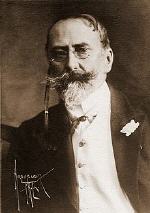
William Merritt Chase was born in Ninevah, Indiana. He studied in Indianapolis, then (in 1869) went to New York and studied briefly at the National Academy of Design. In 1872, after working for two years as a still life painter in St. Louis, several leading citizens and art patrons sponsored a five year trip to Munich where he was greatly influenced by the style of the Munich Artists. Upon his return to New York in 1878 he opened his Tenth Street Studio where he developed a style more vibrant and brightly colored, finding in Impressionism a means of conveying the emotion in both landscapes and city scenes. He did most of his later work in and around New York City, producing both urban and pastoral studies, which were realistically portrayed, yet infused with nuances of light, color, and brushwork, and conveyed the subjectivity of his interpretations. Such were the artistic styles and intentions of Chase; he considered himself a realist, but felt that Impressionistic techniques provided a means of expressing emotions - which are a part of the artists' reality.
Chase was a member of the Ten (Ten American Painters), but also devoted much of his time to teaching, first at his New York studio, than at the Students League. He also taught at his summer home in Shinnecock, Long Island, at the Chase School (which he founded), and later at the New York School of Art and the Pennsylvania Academy of Fine Arts. His students included Marsden Hartley, Charles Demuth , Edward Hopper , Georgia O'Keeffe , and Charles Sheeler. His achievements as an artist and teacher reflect the impact of the Impressionist movement in American culture; Chase not only pursued artistic innovation, but also brought progress to academic institutions of art. He died in New York in 1916.